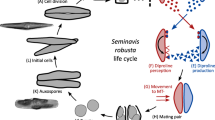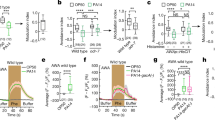Abstract
DIFFUSIBLE polypeptide pheromones (formerly referred to as mating-type factors, sex factors or gamones), which distinguish otherwise morphologically identical vegetative cell (mating) types from one another, are produced by some species of ciliates1,2. Their most striking effect can be observed by exposing cells of one type to a pheromone secreted by another co-specific cell type3. In the presence of this ᤘnon-self ᤙ signal, these cells interrupt their vegetative life to unite temporarily in mating pairs. Thus ciliate pheromones have traditionally been associated only with mating induction2,4. However, the identification of autocrine pheromone receptors5,6 suggests a broader role, which is supported by the hypothesis that ciliates evolved their mating-type mechanism for pursuing self-recognition1. We now report studies, in the cosmopolitan marine sand-dwelling protozoan ciliate Euplotes raikovi, demonstrating that these molecules promote the vegetative reproduction (mitogenic proliferation or growth) of the same cells from which they originate. As, understandably, such autocrine pheromone activity is primary to that of targeting and inducing a foreign cell to mate (paracrine functions), this finding provides an example of how the original function of a molecule can be obscured during evolution by the acquisition of a new one.
This is a preview of subscription content, access via your institution
Access options
Subscribe to this journal
Receive 51 print issues and online access
$199.00 per year
only $3.90 per issue
Buy this article
- Purchase on Springer Link
- Instant access to full article PDF
Prices may be subject to local taxes which are calculated during checkout
Similar content being viewed by others
References
Luporini, P. & Miceli, C. in The Molecular Biology of Ciliated Protozoa (ed. Gall, J. G.) 263–299 (Academic, New York, 1986).
Miyake, A. in Biochemistry and Physiology of Protozoa 2nd edn (eds Levandowsky, M. & Hunter, S. H.) 125–198 (Academic, New York, 1981).
Beale, G. H. Trends Genet. 6, 137–139 (1990).
Kühlmann, H. W. & Heckmann, K. J. exp. Zool. 251, 316–328 (1989).
Ortenzi, C., Miceli, C., Bradshaw, R. A. & Luporini, P. J. Cell Biol. 111, 607–614 (1990).
Luporini, P., Miceli, C., Ortenzi, C. & Vallesi, A. Devl Genet. 13, 9–15 (1992).
Miceli, C., La Terza, A., Bradshaw, R. A. & Luporini, P. Eur. J. Biochem. 202, 759–764 (1991).
Raffioni, S. et al. Proc. natn. Acad. Sci. U.S.A. 89, 2071–2075 (1992).
Luporini, P., Raffioni, S., Concetti, A. & Miceli, C. Proc. natn. Acad. Sci. U.S.A. 83, 2889–2893 (1986).
Stewart, A. E. et al. Protein Sci. 1, 777–785 (1992).
Brown, L. R. et al. J. molec. Biol. 231, 800–816 (1993).
Ottiger, M. et al. Protein Sci. 3, 1515–1526 (1994).
Mronga, S. et al. Protein Sci. 3, 1527–1536 (1994).
Luginbühl, P., Ottiger, M., Mronga, S. & Wüthrich, K. Protein Sci. 3, 1537–1547 (1994).
Concetti, A., Raffioni, S., Miceli, C., Barra, D. & Luporini, P. J. biol. Chem. 261, 10582–10586 (1986).
Olins, D. E. & Olins, A. L. Int. Rev. Cytol. 153, 137–170 (1994).
Miceli, C., La Terza, A., Bradshaw, R. A. & Luporini, P. Proc. natn. Acad. Sci. U.S.A. 89, 1988–1992 (1992).
Luporini, P., Vallesi, A., Miceli, C. & Bradshaw, R. A. Ann. N.Y. Acad. Sci. 712, 195–205 (1994).
Singer, S. J. A. Rev. Cell Blol. 6, 247–296 (1990).
Wells, J. A. Curr. Opin. Cell Biol. 6, 163–174 (1994).
Heldin, C.-H. Cell 80, 213–225 (1995).
Whitbread, J. A., Sims, M. & Katz, E. R. Devl Genet. 12, 78–81 (1991).
Parfenova, E. V., Afonkin, S., Yudin, A. L. & Etingof, R. N. Acta protozool. 28, 11–21 (1989).
Tanabe, H. et al. Biochem. biophys. Res. Commun. 170, 786–792 (1990).
Takagi, Y. et al. Zool. Sci. 10, 53–56 (1994).
Ortenzi, C. & Luporini, P. J. Euk. Microbiol. 42, 242–248 (1995).
Author information
Authors and Affiliations
Rights and permissions
About this article
Cite this article
Vallesi, A., Giuli, G., Bradshaw, R. et al. Autocrine mitogenic activity of pheromones produced by the protozoan ciliate Euplotes raikovi. Nature 376, 522–524 (1995). https://doi.org/10.1038/376522a0
Received:
Accepted:
Issue Date:
DOI: https://doi.org/10.1038/376522a0
This article is cited by
-
Autocrine pheromone signalling regulates community behaviour in the fungal pathogen Fusarium oxysporum
Nature Microbiology (2019)
-
Evidence for methionine-sulfoxide-reductase gene transfer from Alphaproteobacteria to the transcriptionally active (macro)nucleus of the ciliate, Euplotes raikovi
BMC Microbiology (2014)
-
A commensal symbiotic interrelationship for the growth of Symbiobacterium toebii with its partner bacterium, Geobacillus toebii
BMC Research Notes (2011)
-
Detection of a Novel Subspecies of Francisella noatunensis as Endosymbiont of the Ciliate Euplotes raikovi
Microbial Ecology (2011)
-
Receptor Oligomerization as a Process Modulating Cellular Semiotics
Biosemiotics (2010)
Comments
By submitting a comment you agree to abide by our Terms and Community Guidelines. If you find something abusive or that does not comply with our terms or guidelines please flag it as inappropriate.



